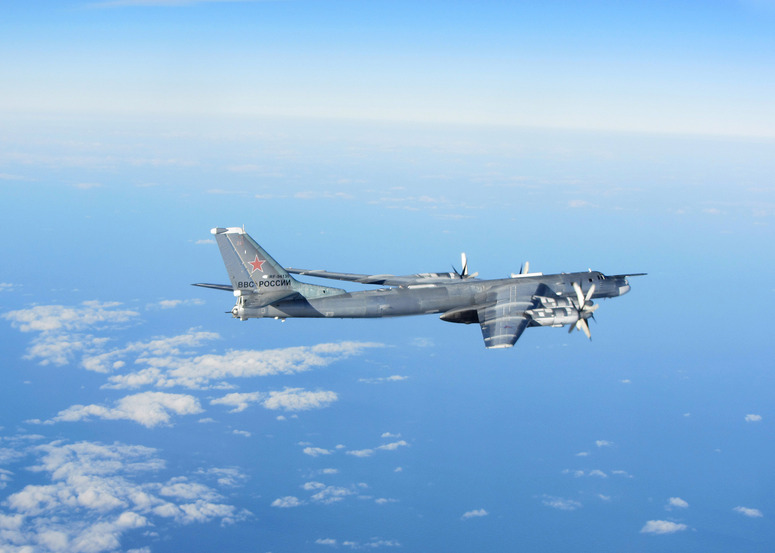A Failed, “Lead From Behind” Foreign Policy (2)
Russian TU-95 bomber intercepted over North Sea/Atlantic Ocean, 29 October 2014
Photo Credit: NATO/RAF
The Obama administration has made the world more dangerous for the West by more than just our withdrawal from Iraq. Indeed by Obama’s demonstration of U.S. weakness, he is enticing Russia, China, and Iran to consider what they each might gain by military force. The photo above of one of eight Russian TU-95 Bear H strategic bombers intercepted by NATO aircraft over the North Sea and Atlantic Ocean is evidence of just one of many incidents of Russia resuming its Cold War ways. Russian Federation President Putin has shown a great interest in regaining its former Eastern European and Baltic state possessions. China meanwhile is working to seize the South China Sea for its own, and at the very least, dominating South-East Asia. Iran, for its part, is working hard to gain nuclear weapons and ICBMs. In addition, their military adventures in Syria, Iraq, Lebanon, Bahrain, and Yemen show Iran has the ambition to become at the very least the suzerain of the Middle East, and quite possibly the master of a world-wide Shiite imamate. In addition, there is the further bad news these three bad actors have formed a de facto alliance that may very well be formalized in the near future. And then there is ISIS.
The question naturally arises while mulling over these foreign threats, what is the U.S. under the Obama administration doing to react to these challenges? Let us count the ways.
Number 1: The Infamous “Red Line”
When faced with the possible use of chemical weapons in 2012 by the Bashar al-Assad regime in the Syrian civil war, Obama warned Assad that their use against his own people would constitute a “red line” that would invite U.S. military intervention. Obama declared to reporters that
We cannot have a situation where chemical or biological weapons are falling into the hands of the wrong people. We have been very clear to the Assad regime — but also to other players on the ground — that a red line for us is we start seeing a whole bunch of chemical weapons moving around or being utilized. … That would change my calculus; that would change my equation.
Nevertheless, the Assad regime repeatedly crossed this red line with no retaliation by the U.S. In 2013 the U.S. reached an agreement with Russia, which had Syria as a client state, to pressure Syria into destroying its chemical weapons. Supposedly, by June 23, 2014 this destruction was complete. Yet, as American attention was diverted to a desultory air war against ISIS, reports were heard of continuing Syrian chemical attacks against Syrian rebels. In the end, the U.S. continued to ignore these Syrian uses of chemical weapons, and Obama’s infamously ignored “red line” must be considered entirely erased.
What are America’s opponents to make of this history, other than they can safely ignore any and all warnings from President Obama? Weak leaders who do not back up their warnings end up being ignored.
Number 2: Obama is weakening America’s armed forces.
In the face of all these military threats to the United States, Obama is reducing the country’s armed forces. Given his ideological perspective from the political Left, it is easy to understand why he wants to do this. What is much harder to understand is how he can not realize how what he is doing is threatening the physical survival of his country.
Currently, the plan is to reduce the Army by 40,000 soldiers and 17,000 civilian employees by October 1, 2017. This Reduction In Force (RIF) amounts to about two full infantry divisions out of a present active force of ten divisions, or a RIF of about 20%. This will shrink the Army to pre-World War II levels.
The Air Force is also slated for a cut of around 10,000 airmen out of an active duty force of 313,000, a RIF of 3.2%. According to breakingdefense.com, the Air Force is fielding the smallest and oldest fleet of combat aircraft in its history.
The Marine Corps was to be reduced by 8,000 marines out of an active force of 182,000, but they are now planning to hold at 182,000.
The Navy is the one service that currently has plans for a slight increase, from the current 325,000 sailors to 328,000 sailors over the next five years, an increase of about 1%.
The biggest cuts however are scheduled in strategic anti-missile defenses. Last year the Pentagon’s Missile Defense Agency had its first real-dollar increase since 2011 with a budget of $7.5 billion. This year it was increased again to $8.1 billion, but after fiscal 2016 it is scheduled for a 25% decrease. This is especially troubling given the highly likely future clashes with Russia, China, and Iran.
Number 3: Obama’s nuclear agreement is paving the way for Iranian nuclear weapons and ICBMs.
The P5+1 (the five permanent members of the UN Security Council plus Germany) nuclear agreement with Iran does little to reduce Iran’s capability to produce nuclear weapons in the future. This is primarily due to the ineffectual inspection requirements for Iranian nuclear sites in the agreement. The supreme leader of Iran, the Ayatollah Ali Khamenei, declared on June 23 that Iran’s military sites were strictly off-limits for any verifying inspections. The deal does require inspection of suspect facilities with 24 days notice (more like three months when all prescribed procedures are followed according to the Wall Street Journal). This gives Iran plenty of time to disguise or dismantle any evidence.
Also, there is nothing in the agreement restricting Iran from developing ICBMs, which make sense only if Iran gives them nuclear warheads. An unclassified U.S. Defense Department report, Fiscal Year 2014 Annual Report on Military Power of Iran, January 2015, notes that Iran is developing this capability.
In addition, more than $100 billion in frozen Iranian assets will be released to Iran under the nuclear agreement. This will allow them to financially support their terrorist allies, such as Hezbollah and Bashar al-Assad of Syria. The U.S. State Department considers that in 2014 “Iran’s state sponsorship of terrorism worldwide remained undiminished”.
Number 4: Obama is supporting the air war against ISIS to the minimal degree possible.
Three retired generals, one Air Force and two Army generals, have stated that the current level of air attack is close to being insignificant. It would appear that Obama is authorizing only enough strikes to deflect accusations that he is doing nothing.
Number 5: Obama’s inaction in the war with ISIS is opening the way for Russian-Iranian dominance of the Middle-East.
With ISIS wreaking havoc in both Syria and Iraq, and with Obama doing next to nothing to stop them, Russia and Iran have been given the opportunity to fill the power vacuum. As we have noted in three earlier posts — Russia inside Syria, Russian Military Operations in Syria, and Sitrep on Russia’s Syrian Campaign — Russia and Iran, especially Russia, are seizing this opportunity. If Obama does not do something more, we can expect Russia and Iran to end up as the suzerains of Syria and of at least the Shiite part of Iraq.
Number 6: Obama’s weakness is creating an existential threat for both Western and Eastern Europe from Russia.
As was discussed in The Growing Threat of Russia, Vladimir Putin has a very real desire to reassemble the former Soviet empire under Russia. Besides his adventures in the Ukraine and Georgia, he has presented military threats to the Baltic States and Sweden.
All of these aspects of President Obama’s foreign policy can be described only as complete failures with no apparent successes. It is often said that every dark cloud has a silver lining, but I sure wish I could perceive the silver lining in this one.
Views: 3,310






























